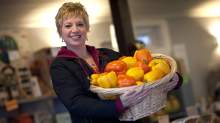This month’s e-newsletter from my local health food store, Nature’s Fare Markets, included an excerpt on how to easily sprout beans and grains. As this is something I’m hoping to do more of (especially if it’s as easy as they say), I thought I’d share the tips with you…
“Sprouting at home is an easy and cost-effective way to add enzymatically-active, highly alkalizing food to your daily routine. What should you sprout?
- Amaranth
- Buckwheat
- Beans (all kinds)
- Chickpeas
- Lentils
- Quinoa
- Sunflower seeds (and more!)
How to Sprout in 10 Easy Steps
You can buy sprouting kits in most health food stores, but it’s just as easy to sprout at home using three readily-available household objects: a jar, cheesecloth and a rubber band. Here are the ten steps to sprouting:
- Rinse the seeds you intend to sprout well and pour into the jar (fill to 1/4 mark)
- Fill the jar at least 3/4 full of water
- Soak overnight at room temperature
- Pour out the water and seeds and rinse with fresh water
- Return the seeds to the jar
- Cover the jar with cheesecloth and secure the cloth with the rubber band
- Briefly turn the jar upside down to drain the remaining water
- Sprouts will begin to appear within 24 hours (give or take)
- Make sure the sprouts stay moist so they sprout fully by rinsing and draining them (as in step #7)
- Rinse your sprouts before eating.
Sprouts can be stored in the fridge uncovered for up to one week. Happy sprouting!
Credit: Excerpt from The Thrive Diet / Thrive: The Vegan Nutrition Guide by Brendan Brazier


